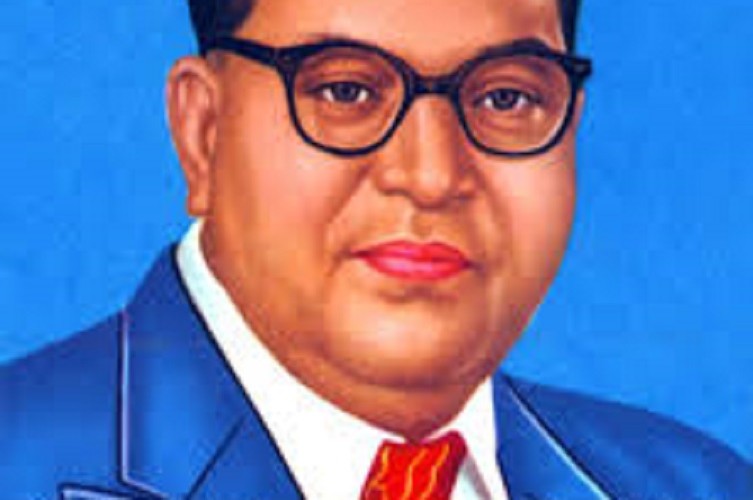In the wake of the recent IIT Madras controversy, we are witnessing the unfortunate phenomenon of Dr. B.R. Ambedkar’s august name being dragged in for petty political gains—from the Nehru-Gandhi scion of the Congress suddenly recalling Ambedkar’s name to certain nationalist groups claiming ownership of Ambedkar’s legacy.
But in the midst of this controversy, some old issues have been revived and reintroduced into the public discourse. Some old fallacies we believed were buried under the debris of falsehoods perpetrated by ‘secular scholarship’ have been revived. This illustrious list includes ‘Aryan invasion’, ‘Hinduism is torture’, ‘Hinduism is anti-egalitarian, misogynist’ and so on.
Here is a patently misleading canard propagated by the Ambedkar Periyar Study Circle in IIT-Madras:
 As expected from self-proclaimed ‘secular’ group, they quote statements without providing the circumstances under which the statements were made. The following quote by Aravindan Neelakandan gives us the context:
As expected from self-proclaimed ‘secular’ group, they quote statements without providing the circumstances under which the statements were made. The following quote by Aravindan Neelakandan gives us the context:
His vehement criticisms of mythologies and epics in the unfinished manuscript, which today forms the book ‘Riddles’, are actually the pain of a passionate patriotic Dalit leader who loved the Hindu culture and society but was thrown out literally by the arrogance of Hindu orthodoxy.
This fact has been accepted by almost all activists, leaders and scholars identified as ‘Hindutvawallahs’, but since APSC has provided excerpts we feel the same needs to be done to give a nuanced picture. To start with the ‘Hinduism is torture’ excerpt this is what the good doctor stated in ‘Riddles in Hinduism’:
The Hindu Religious and Philosophic thought gave rise to an idea which had greater potentialities for producing social democracy than the idea of fraternity. It is the doctrine of Brahmaism…
This being the truth, it will be instructive to read some key statements Dr. Ambedkar made on other such sensitive issues:
A. On Aryan Invasion
From page 68 of his monumental ‘Who were the Shudras?’:
(1) The Vedas do not know any such race as the Aryan race.
(2) There is no evidence in the Vedas of any invasion of India by the Aryan race and its having conquered the Dasas and Dasyus, supposed to be natives of India.
(3) There is no evidence to show that the distinction between Aryans, Dasas and Dasyus was a racial distinction.
(4) The Vedas do not support the contention that the Aryans were different in colour from the Dasas and Dasyus
B. On caste
- While I reject the Vedic Varnavyavastha for reasons given in the speech, I must admit that the Vedic theory of Varna as interpreted by Swami Dayanand and some others is a sensible and an inoffensive thing. It did not admit birth as a determining factor in fixing the place of an individual in society. It only recognized worth. (Annihilation of Caste, page-48)
- The transformation of Varna into Caste is the most stupendous and selfish task in which Brahmanism after its triumph became primarily engaged. ( Revolution and Counter-Revolution in Ancient India, page-117)
- The system of Chaturvarna of the Pre-Buddhist days was a flexible system and was an open to system. This was because the Varna system had no connection with the marriage system. While Chaturvarna recognized the existence of four different classes, it did not prohibit inter-marriage between them. . ( Revolution and Counter-Revolution in Ancient India, page-122)
- Not only was Shudra free to study the Vedas but there were Shudras who had reached the status of Rishis and has been composers of the Hymns of the Vedas. (Revolution and Counter-Revolution in Ancient India, page-233)
C. Role of Women in ancient (read Vedic) society
- Panini’s Ashtaadhyai bears testimony to the fact that women attended Gurukul and studied the various Shakhas of the Veda and became expert in Mimansa. Patanjali’s Maha Bhashya shows that women were teachers and taught Vedas to girl students. The stories of women entering into public discussions with men on most abstruse subjects of religion, philosophy and metaphysics are by no means few. (Revolution and Counter-Revolution in Ancient India, page-240)
- The story of public disputation between Janaka and Sulbha, between Yajnavalkya and Gargi, between Yajnavalkya and Maitrei and between Shankaracharya and Vidyadhari shows that Indian women in pre-Manu’s time could rise to the highest pinnacle of learning and education. (Revolution and Counter-Revolution in Ancient India, page-240)
- Among the Ratnis who played so prominent a part in the coronation of the King in Ancient India was the queen and the King made her an offering as he did to the others. Not only the king elect did homage to the Queen, he worshipped his other wives of lower castes. (Revolution and Counter-Revolution in Ancient India, page-240)
- In the days of Kautilya there was no ban on woman or a widow remarrying. (Revolution and Counter-Revolution in Ancient India, page-242)
IndiaFacts Staff articles, reports and guest pieces

